How To Be A Travel Writer Blog
Last updated: 1st September 2021.
Starting a travel blog is the best decision I've ever made.
Through this site, I've funded ten years of full-time travel and gained a book deal for my travel memoir, along with a big New York City agent. I've been featured in large publications, like the Wall Street Journal, the Independent, and the BBC. I've been interviewed on the radio in front of an audience of 1.6 million listeners. I make a comfortable six figures each year in entirely passive income, meaning the money comes in whether I'm working or not.
And yet, before starting Never Ending Footsteps, I had zero writing experience, had no idea how to run a website, didn't really know what a blog was, and had never heard of WordPress.
I didn't even own a camera.
I'd just graduated from college with a physics degree and was fully intending to throw myself into a career in particle physics — that is, after I took a year-long round-the-world trip.
Guys, I've now been travelling full-time for over ten.freaking. years. That's ten years of travel paid for entirely through this travel blog. I want to cry when I think about it.
But success to me isn't just about the money, the book deal, and media mentions.
Running Never Ending Footsteps has led to life-changing friendships with some of the most fascinating and inspirational people I've ever met. It's taught me dozens of new skills and helped me conquer a multi-year battle with anxiety and an eating disorder. I even found my boyfriend of ten years through my travel blog!
So yeah, I'd say starting a travel blog was the best decision I've made.
There are approximately seventeen bajillion articles describing how to start a travel blog out there and I hesitated throwing my take into the mix for many years because of it. After reading several of these articles and cringing my way through them, though, I couldn't hold back. I wanted to write an article about how you can actually set yourself up for the best chances of success. I want to show that you can build a six figure business without selling out. That you can be unconventional and embrace your weirdness and find a community of people who love you — without going broke.
You don't need to do what everyone else is doing — in fact, I recommend actively avoiding it. In a space so crowded as the travel blogging world, you should stand out and that's why my guide is the one you should follow. It's one that's based around what will give you the best chances of success in 2021.
With that out of the way, let's get started!
Here's how to start a travel blog in 2021:
- Find the perfect name to suit your personality
- Set up hosting for your blog
- Install WordPress
- Learn how your blog's dashboard works
- Download a lightweight, user-friendly theme
- How to design a logo
- Install these essential plugins
- Start making money from day one (yes, it's possible!)

Step One: Coming Up With a Name for Your Travel Blog
Finding the perfect name feels as though it should be one of the most challenging aspects of starting a travel blog. In reality, though, as long as your chosen site name isn't offensive or strange, you'll be all good.
When you're focusing on making passive income (money you make while you're not actively working) through a travel blog, the name of your site becomes less important. Within a year of starting your travel blog, ninety per-cent of your traffic is going to come from Google (rather than social media), and in this situation, the name of your site doesn't matter.
Think about it: when you're searching online for travel tips, how much attention do you give to the names of the travel blogs you end up visiting? You probably don't even notice it until you're actually on the site! That's why the name is less important than you think. If you can rank in Google (don't worry — I'll teach you how to do that!), you can get yourself on the first page of the search results, and you can easily make money from that traffic. The name of your blog? It could be anything, and you would still be pulling in that income.
With that being said, here's what I recommend keeping in mind:
Find a way to stand out: Names like Nomadic [name], Adventurous [name], Backpacking [name], [name]'s Travels, and Wandering [name]have all been done to death, and it's unlikely you'll find success with them. Is anyone going to remember Nomadic John when Nomadic Matt is already well-known? Probably not.
What about your name?: If in doubt, register your own name as the name of your travel blog! Why not? You're never going to grow out of it, it's an accurate representation of who you are, and it makes branding a hell of a lot easier.
Don't forget to take a long-term view: Don't call your blog Travel For a Year if your trip has the potential to last longer; don't call yourself The Thirty-Year-Old Traveller for the same reason. Having a travel style in the blog name — like Backpacking James or Ruth Loves Luxury Travel could cause problems down the line if you decide, for example, you no longer want to stay in dorms every night.
Keep it classy: If you're hoping to eventually end up taking press trips or working with companies in any capacity, think about how you'll feel when handing over your business card or pitching for a trip. "Hey, I run the successful travel blog, "Sex, Drugs, and Travel" won't necessarily make for the best first impression — although it would probably get me to subscribe, haha. Imagine introducing your site to the CEO of a tour company to see if it feels right. Imagine being ten years older than you are now — will the name hold up when you're 40 or 50 or 60?
Make the url as easy as possible to remember:I'd avoid a site name that contains more than around four or five words, and I'd also recommend against using hyphens, because they make it tricky to describe your site address to people. Imagine being on a podcast and having to say, "my site is travel hyphen like hyphen a hyphen local," or, "my site is Travel Like a Local with hyphens in-between every word." Most bloggers I know with hyphens in their url has come to loathe it.
Similarly, long, complicated words can make it tough for people who may not know how to spell them off the top of their heads. And keep in mind that not everybody uses American English or British English — if you call your blog something like My Favourite Places or The Bold Traveller, not everybody will spell those words in the same way, so may not be able to find your site.
Make sure the .com domain name is available:It's not that important, but people are so used to websites ending with .com they'll probably forget any other domain extension. If my domain name was neverendingfootsteps.ca, for example, I bet half the people would automatically type .com and struggle to find my blog!
Check out the social media options before buying the domain:Before purchasing your domain, make sure that the name of your site is available on every social media network you can think of. Especially important is Facebook, Twitter, and Instagram. It's not the end of the world if your chosen site name is too long for a username, though, because you can modify it slightly. I'm NEFootsteps on everything but Facebook, for example. And if you're really in love with your blog name, just use your actual name for social media — lots of people do that these days.
Think of puns and quotes: If you're really struggling, I suggest finding a long list of travel quotes and seeing if any of them resonate. Do you have a favourite inspirational saying that you can work into a blog post name? Can you think of a play on words with your name to twist it into a travel-themed phrase? How about your favourite songs? Are there any lyrics that resonate with your current mindset?
How Did I Choose Never Ending Footsteps?
I opted for Never Ending Footsteps for the name of my travel blog because it's one that can grow with me. It doesn't link me to a particular travel style, specific age, or length of trip. I wanted to choose a site name that didn't include my name because — thinking long-term! — it would be easier to sell my site somewhere down the line if it wasn't tied to me as a person. Finally, I liked that, while Never Ending Footsteps evokes a sense of travel, I could potentially transition it into something else in the distant future. Never Ending Footsteps would work as a name for a hiking blog or a personal development site, for example.
Let's move on to the next step!
Step Two: Setting Up Hosting
(Full disclosure, as always: This blog post contains affiliate links. If you decide to purchase through one of these links, I receive a commission from the sale at no additional cost to you.)
Hosting was the scariest part for me, because what even is hosting? When I started out I had no idea. Fortunately, it's quick and easy to get it all set up.
Hosting is essentially a home for your travel blog — it's where it lives on the internet. So in order to have your website exist, you need to sign up with a host. What your host does is provide the physical servers for your website to live on, maintain the software required to keep your site online, and perform regular maintenance to keep your site up and running smoothly. Honestly, I personally don't really understand much more than that, so don't panic if you're baffled by what on earth I'm going on about. You don't need to know how it all works to get your blog set up — I'd say 95% of travel bloggers couldn't explain what hosting actually is to you.
All you need to know is that: you need it.
I've tried and paid for four different budget hosting companies over the years and had countless issues with all of them apart from Bluehost! They're the host I recommend most. I use them every single time I start a brand new blog. In fact, right now, two websites I own are using Bluehost hosting. In other words, I'm putting my money where my mouth is: I use this myself!
And exciting news time! I've reached out to Bluehost and got them to agree to give readers of Never Ending Footsteps a discount on their hosting! When you use this link, you'll pay just $2.95 a month, rather than $8.99.
Bluehost is also one of the cheapest options around, their live chat support team are helpful, friendly, and can usually fix issues within minutes, and — bonus! — you'll receive your domain name (the url of your site) for free. Setting it up should take you less than ten minutes, and I promise it's super-easy.
Head to Bluehost's homepage. This is what you'll see:

Hit that green button that says "Get Started Now" and you'll be redirected to a page outlining their different hosting plans:

I recommend the cheapest plan, for $2.95 per month — that's the one I always use. Those more expensive plans really don't offer anything extra that you need, as they're mainly for people who want to host more than one website. That's not you, so click select on the basic plan and you'll be sent to the following page:
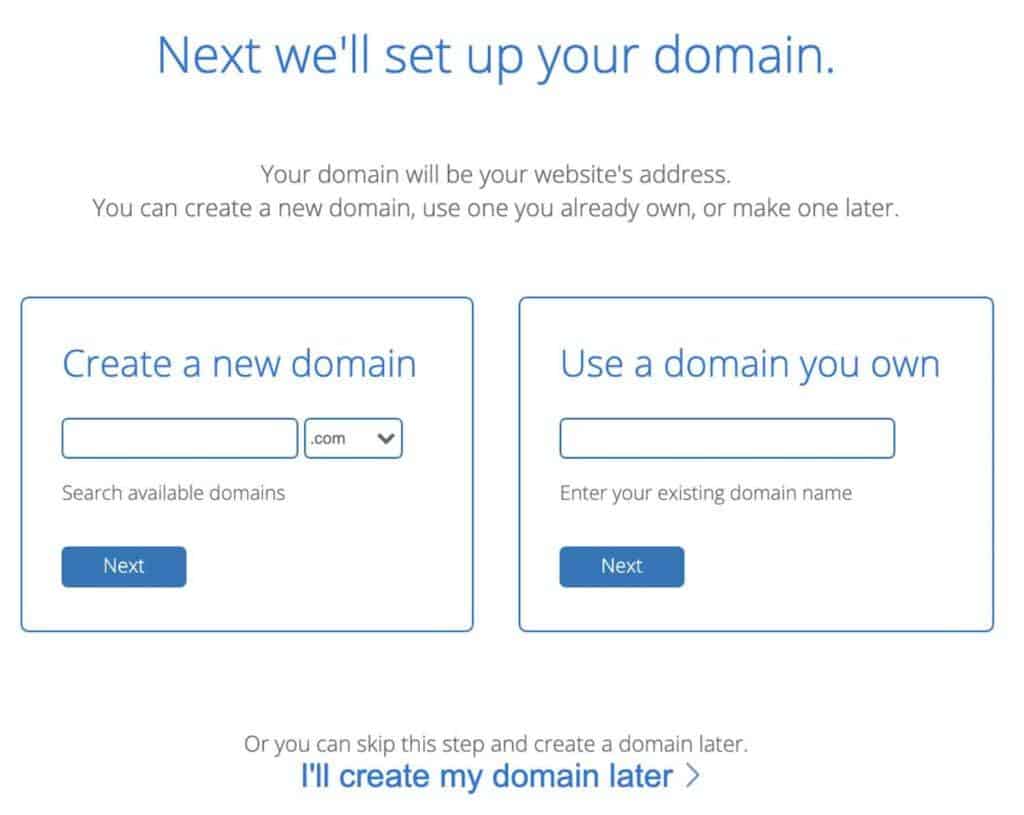
This one's easy! Type your chosen blog name into the box on the left and click next. Check the name multiple times for spelling errors! Now check it again. You wouldn't believe how many people register a domain name with a spelling mistake in it and don't realise until everything is set-up and paid for.
On the next screen, fill in your name and address, and then your package information. Here's what I always choose when I'm starting a new site:
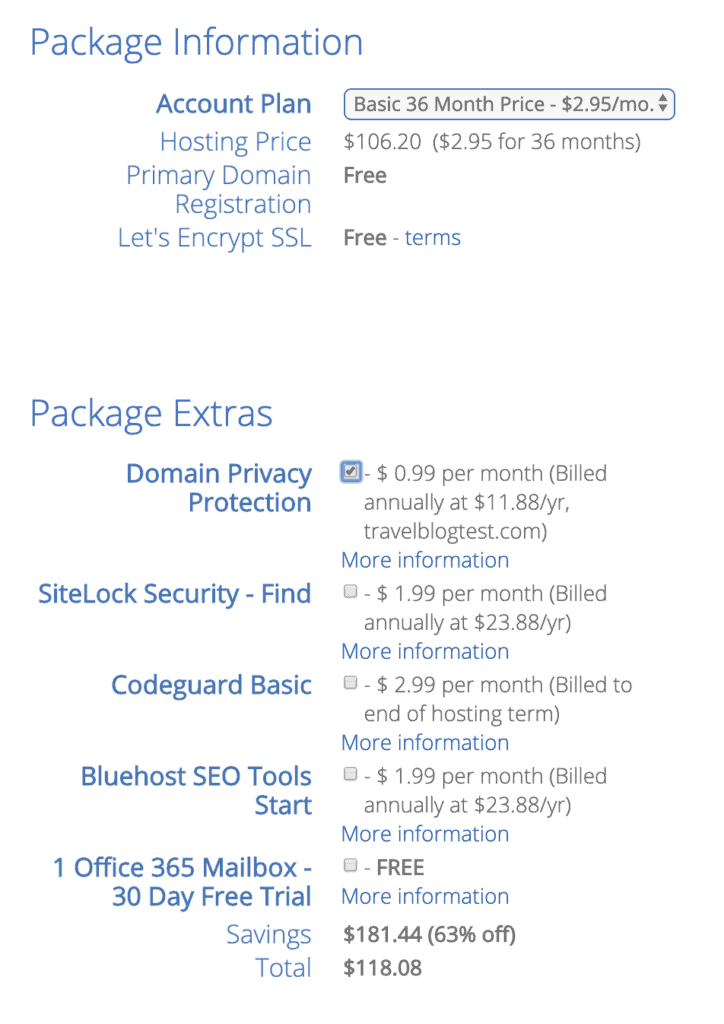
I recommend starting out with the 36 month plan. It works out to be $2.95 per month rather than $5.95 a month for the 12 month plan, saving you almost $50 over those three years. Sure, investing in your blog is a big commitment, but if you're aiming to build a successful one from the beginning, it's important to get into the right mindset. If you go into it thinking you'll still be running your site in three years, you'll be more likely to make it happen. Plus, it's cheaper over the long-term!
As for package extras, most of that is stuff you definitely don't need. Get the domain privacy protection (that means people won't be able to look up your personal address details via your site name), but everything else is absolutely not needed.
Finally, fill in your payment information and you're good to go!
Bam! You've now set up your hosting and domain name — easy, right?
Step Three: Installing WordPress
Now that you've signed up for hosting, it's time to install WordPress. After completing your Bluehost purchase, you'll be asked to choose your password for WordPress.

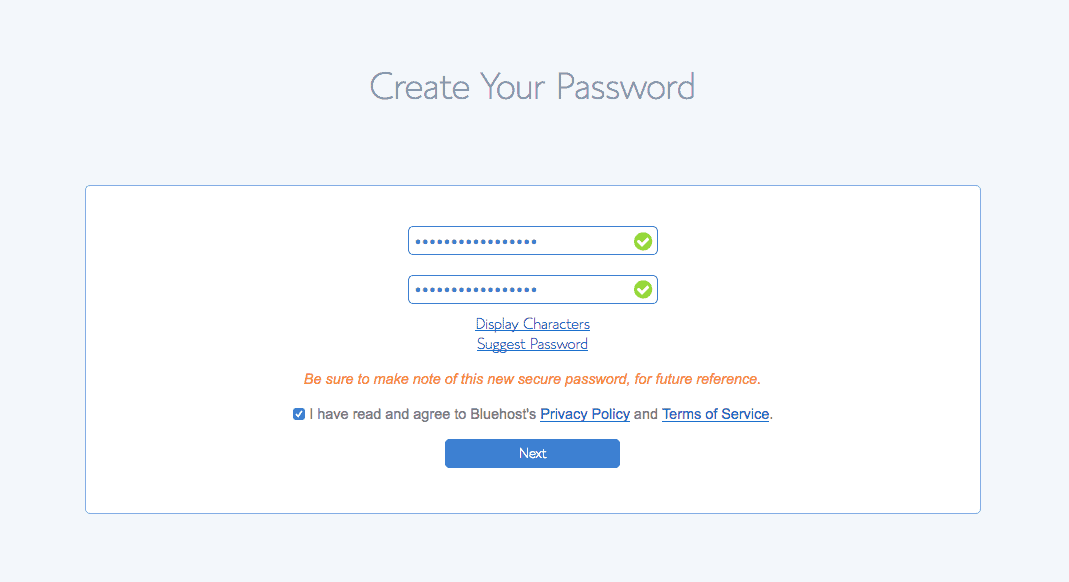
Bluehost will then ask you to pick a theme that appeals most to you. Don't put too much thought into this — it's not permanent; it's just a placeholder for now.
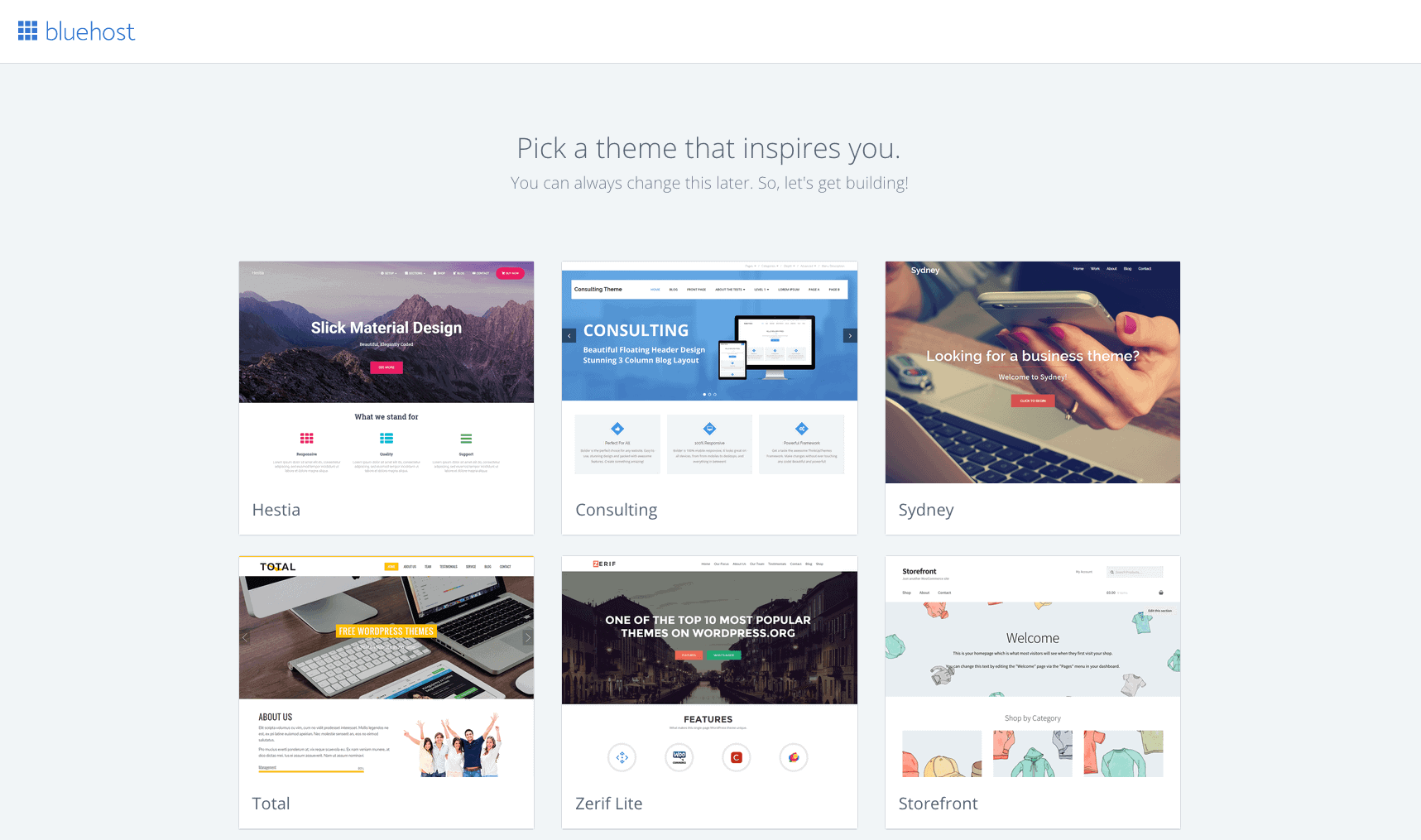
After you've chosen a theme, hit that button that says start building, and it's time to, um, start building!
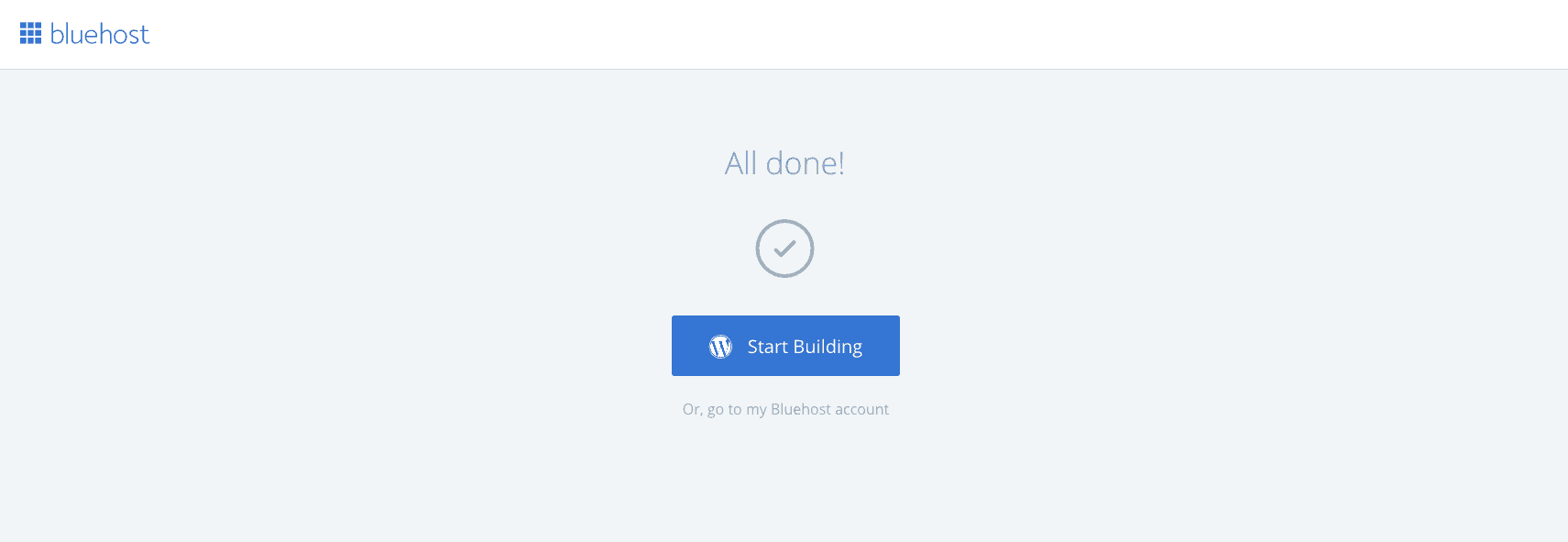
Next, you're going to be asked whether your site is business or personal. You're going to want to eventually have a travel blogging business, so of course you should click on business (exciting!)
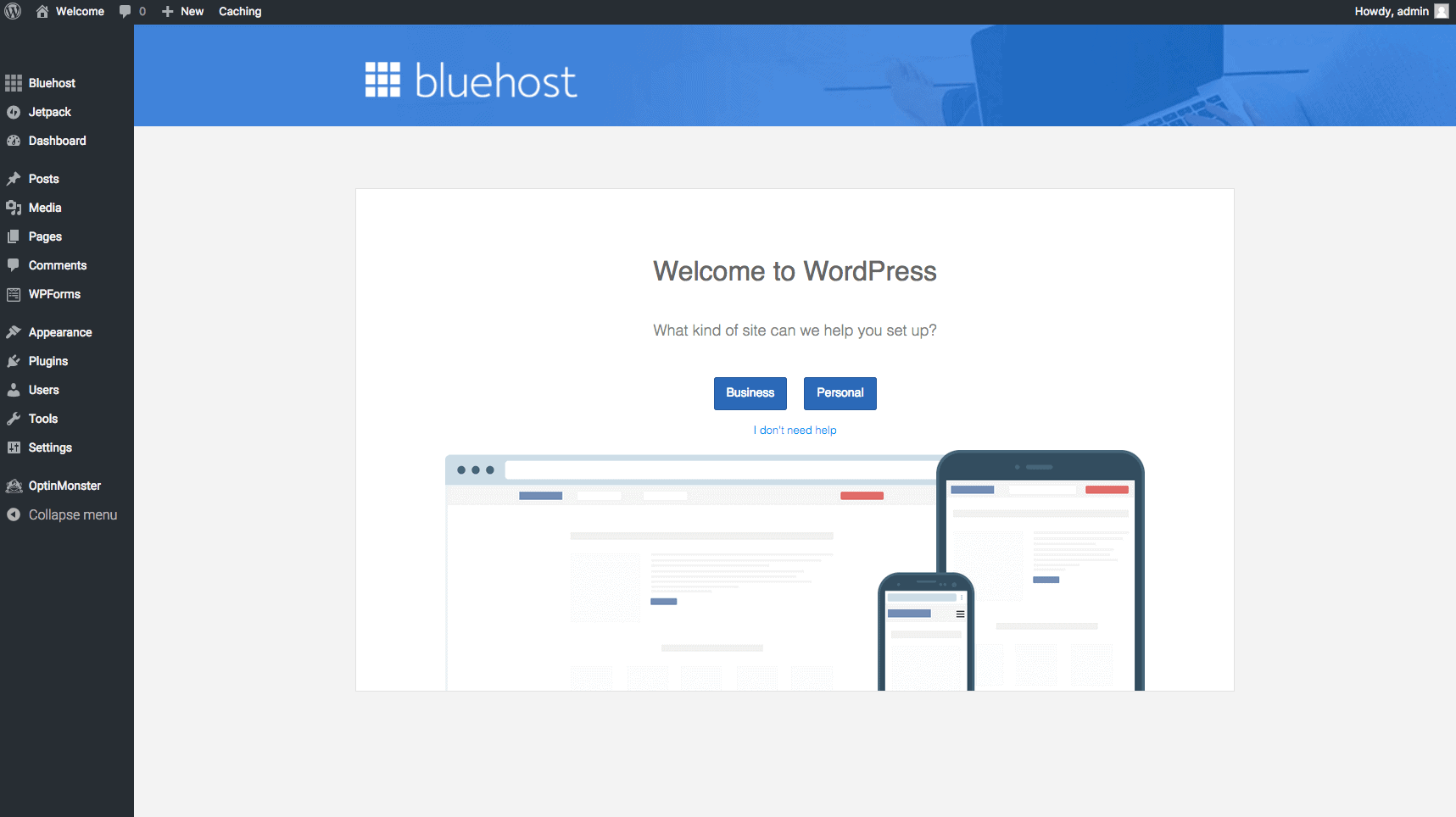
Fill in your site's name and slogan in the boxes that appear on the screen. Again, don't worry too much about the slogan — you can change that as you play around with different ideas for your site.
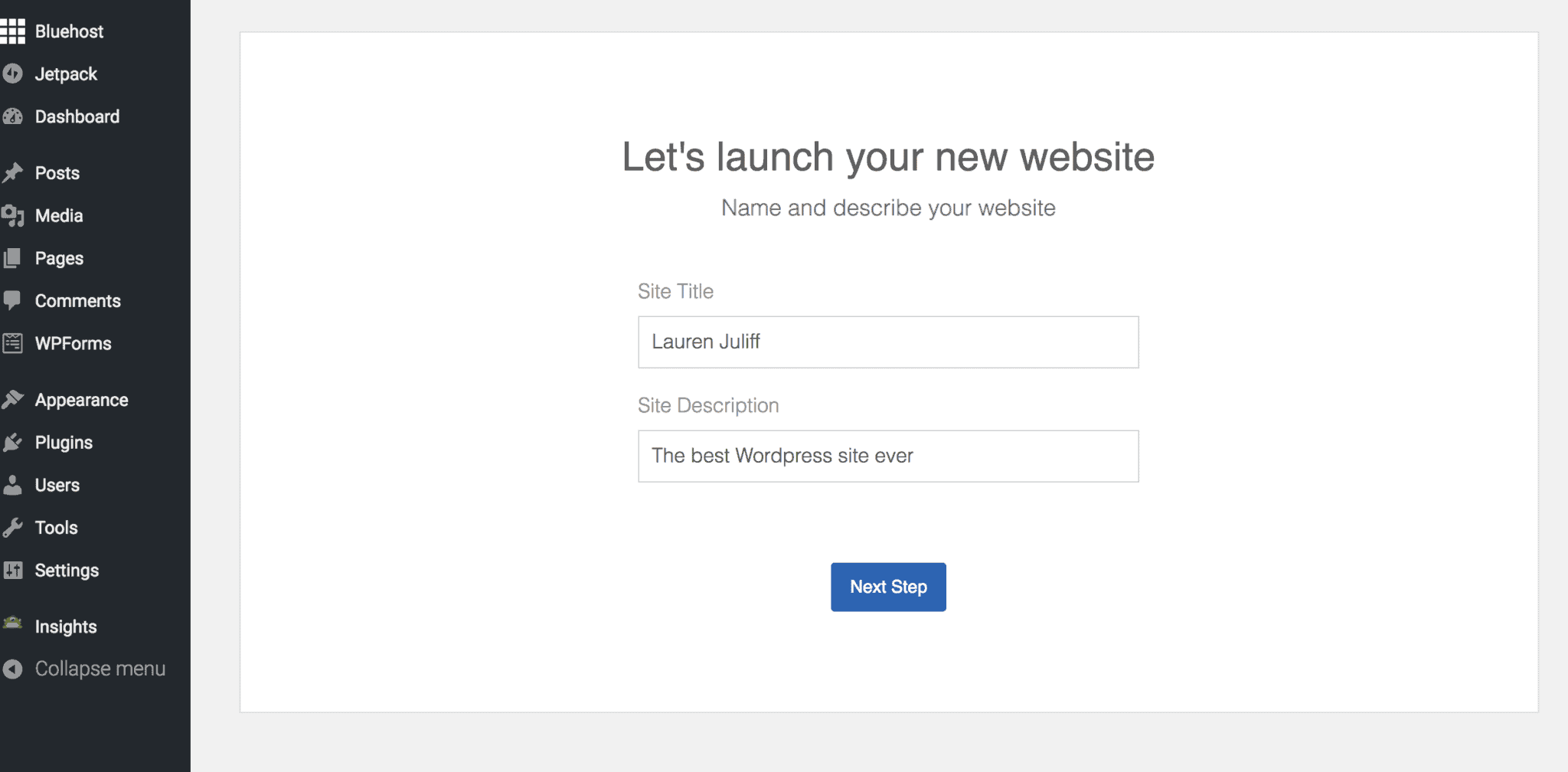
You're going to want to select yes on the next screen.
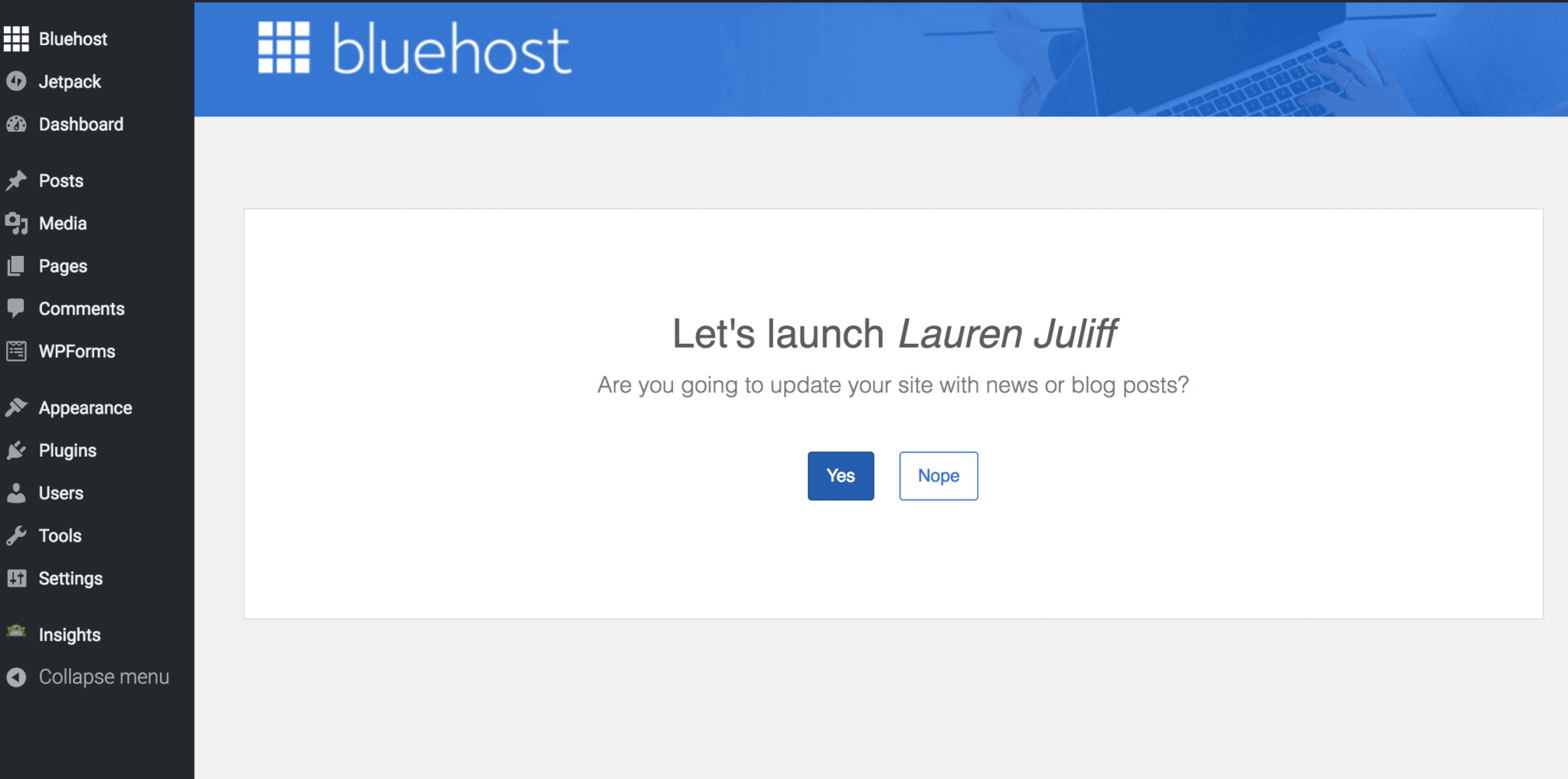
Choose a static welcome page here, as those look far more modern.
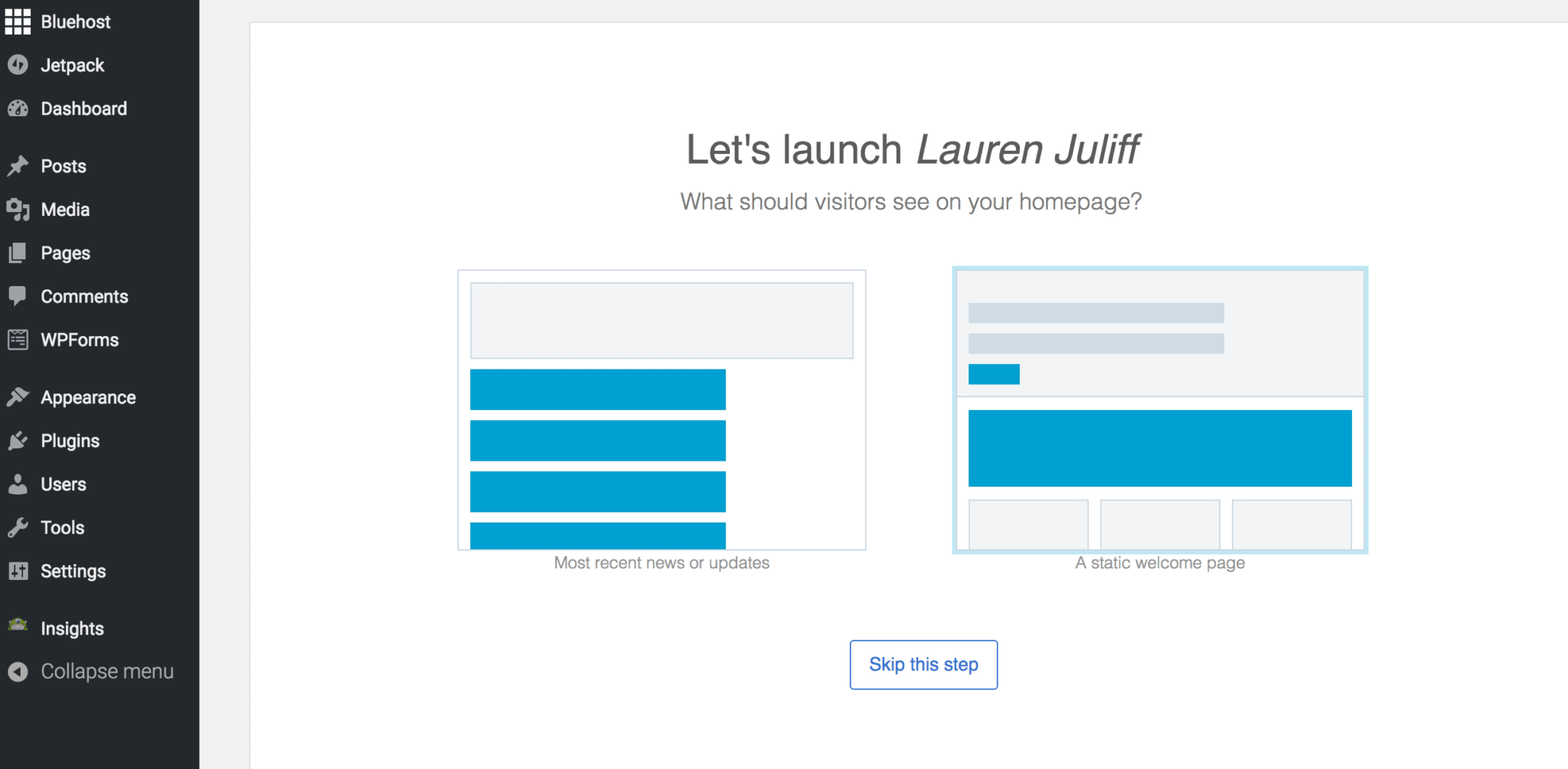
On the next screen, WordPress will ask for your address, so make sure you hit "not now", because your business address is likely your home address right now and you don't want the entire internet rocking up to your door to ask you to plan their trips for them.
Also click "not now" when it comes to installing WooCommerce. You may eventually want to start selling things through your travel blog, but now isn't the time to start worrying about that.
And the complicated bit is done! The screen below means that you're now the proud owner of a WordPress travel blog. Congratulations!
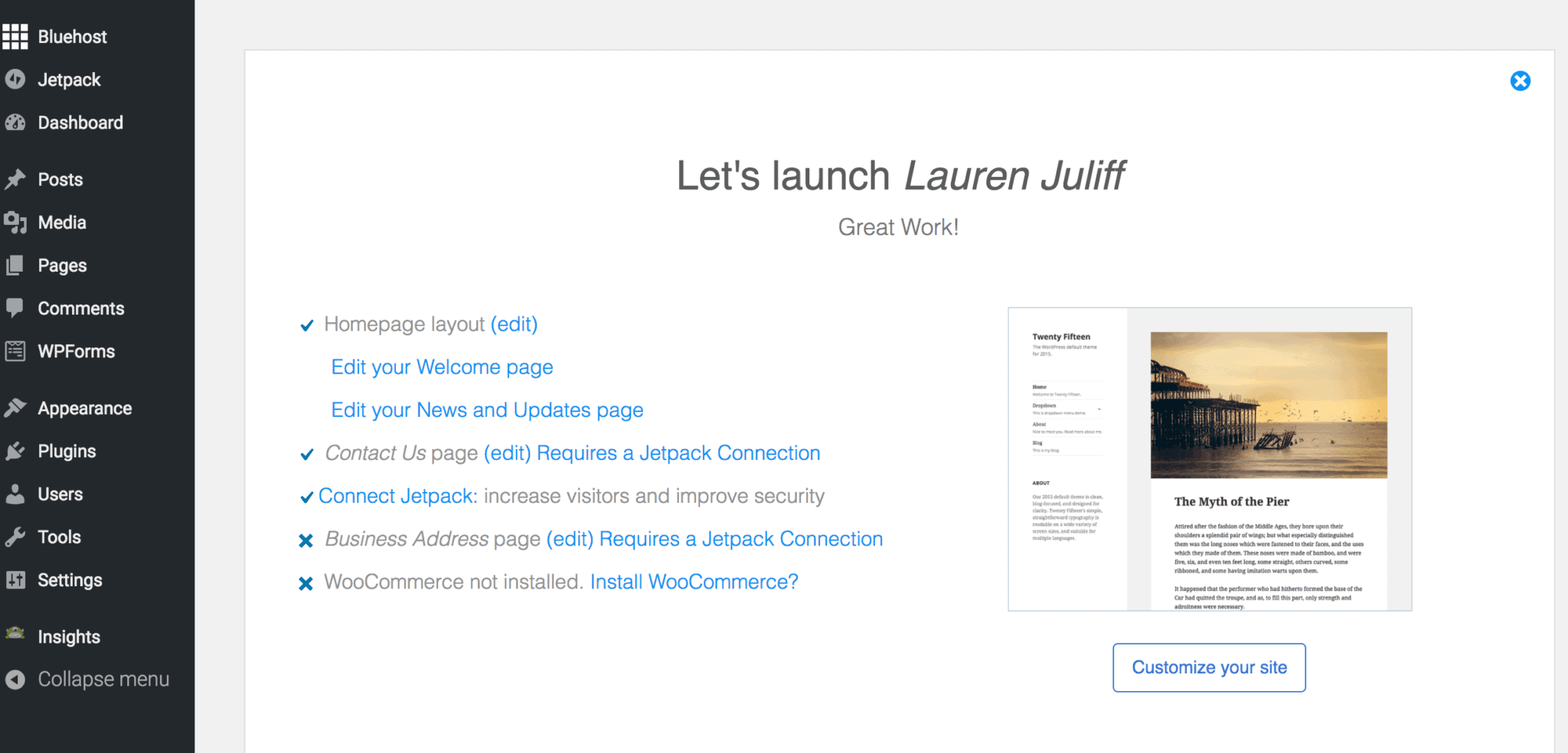
So, um, what on earth do you do now?
Step Four: Logging In to Your Site
It's super-simple. Head to http://yourdomainname.com/wp-admin and you'll see this screen:
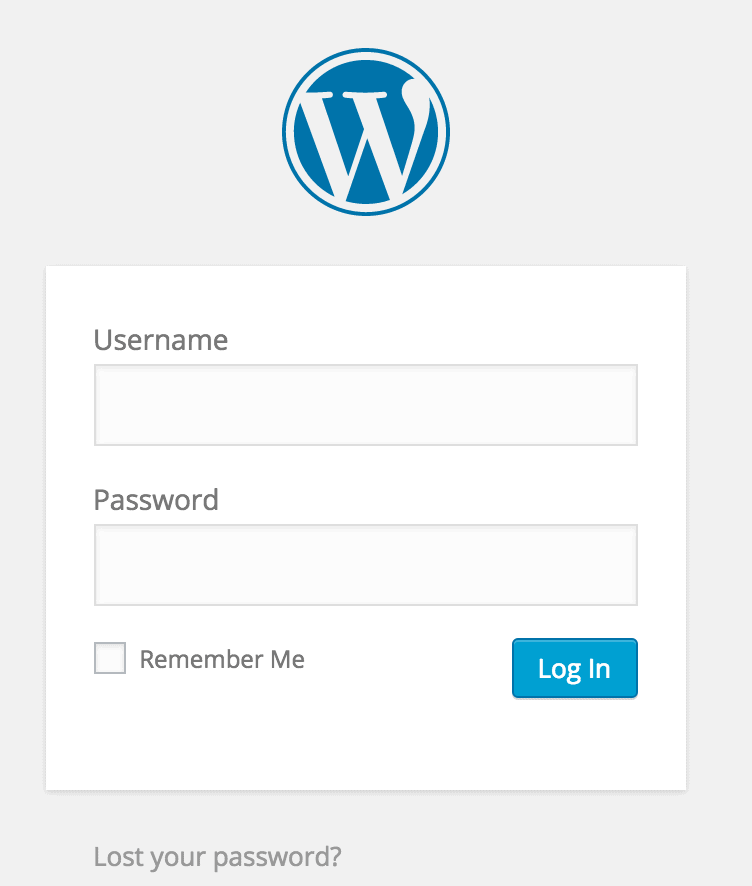
Type in your username and password and you're in!
That screen you now see is your WordPress dashboard and that's where you'll be running your business.
Down the left-hand side, you have all of the important stuff
- Posts (for writing articles for your readers)
- Pages (for static pages on your site, like an about me or contact page — these will be shown on the navigation bar at the top of your site at all times and will be easily accessible to your readers)
- Comments (where you'll approve, spam, or reply to comments on your articles from readers)
- Appearance (where you'll alter the look of your site by installing a new theme, editing its code, and adding sections to your sidebar)
- Plugins (for adding additional features to your site)
- Settings (where you can alter your site settings).
It all sounds a little overwhelming right now, but I promise it'll all fall into place within a day or two.
Here's what your next steps should be in order to get your site live and kicking:
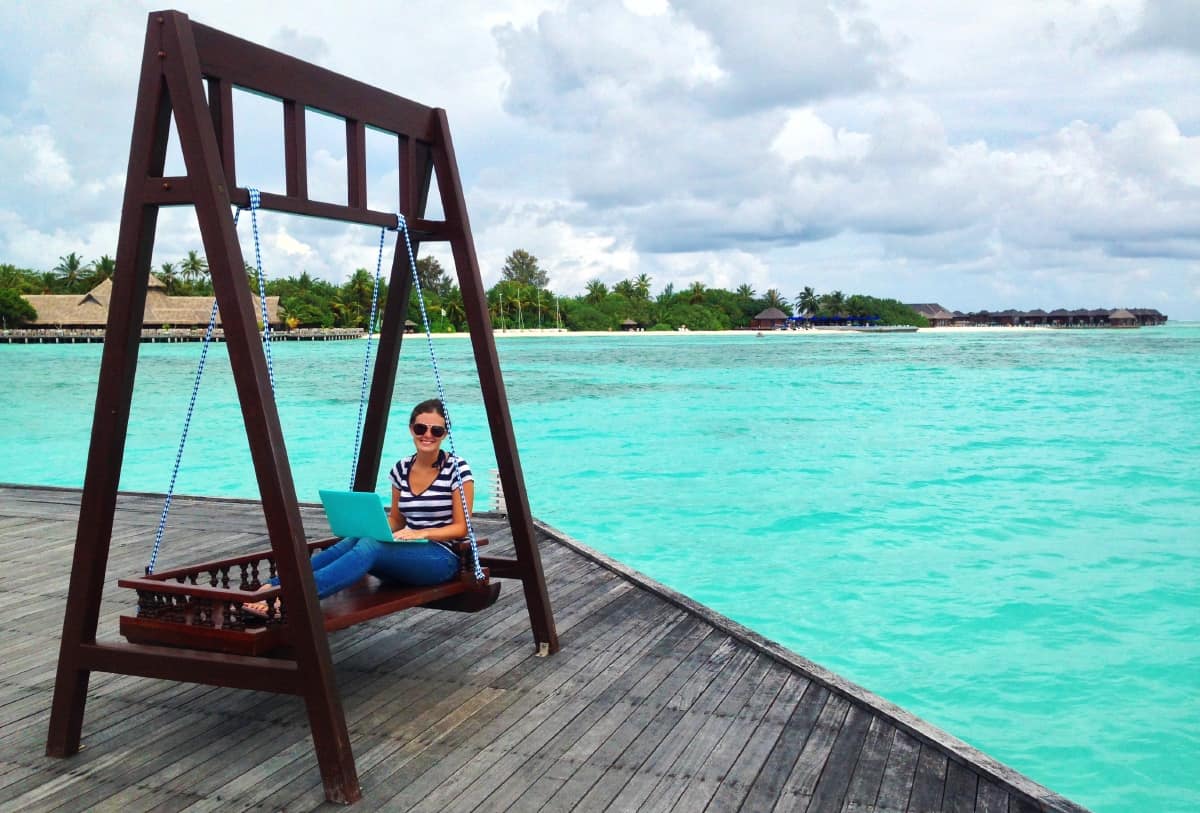
Step Five: Finding a Theme
It's time to make your site pretty! Your website theme is how you're going to personalise your site to get it looking exactly how you're currently hoping it will. Here are a couple of options for finding a theme, and I've used both of these on Never Ending Footsteps:
Elegant Themes: The very first version of my blog used an Elegant Themes theme (Divi is my favourite), and I made my way through several other ones during my first couple of years. For $89 a year, you'll gain access to 87 professional-looking themes. It's great value for money, getting to choose from such a wide selection means you can play around with different designs, and the support team always managed to solve any problems I was having within 24 hours. You can browse all of the designs before signing up, too!
ThemeForest: If you want to use a theme with an even slicker design head to ThemeForest. There, you'll pay around $50 per theme (the price varies, but averages out at around $50), but the themes available have hundreds of options for customisation and have a support team to solve your queries within a few hours. I'm currently using a ThemeForest theme on Never Ending Footsteps and I love it!
Once you've bought a theme, it's time to install it on your site.
Themes will usually include installation instructions, so this shouldn't be difficult at all. On Themeforest, for example, you'll be able to download an installable WordPress file.
Once you've downloaded the file, you can log into WordPress, click on Appearance – Themes – Upload, upload the zip file you've just downloaded from Themeforest, and you'll be on your way to a beautiful site.
Prepare to spend a week or two customising your theme, learning how it works, and getting everything to look exactly how you want. This part can be overwhelming at times, but don't panic — whenever I install a new theme, I find myself still optimising it a month later. It's something you'll probably work on for a while, so there's no need to get it perfect right away.
If you're having problems and want to get your site looking a certain way, you can use the support forums on Elegant Themes or Themeforest to get help from the theme's creator.
And if you're really struggling, just drop me an email. I've installed and customised themes for over 30 travel bloggers now, so I can probably show you exactly where you're going wrong.
Step Six: Getting Yourself a Logo
A logo/banner/header is what you'll use to differentiate yourself from other bloggers, so it's kind of a big deal. But I'll jump in here and say that I don't think it's something you need to put a huge amount of time or money into in the beginning stages of your blog. More important is your kickass content, then once you've started to build a following, you can pay more attention to your site's design. As with practically everything in life, you'll gain more benefit through investing money early on, but if you want to cut corners, this is where I recommend doing so.
Here's what I recommend:
Canva: Canva is completely free to use, so if you're starting your travel blog with a tight budget, this is a great option. Once you've created an account and signed in, click on create a design and play around with any of the banner-sized options. If you click on, for example, Tumblr Banner or Logo, you'll find a list of pre-made templates that you can customise with your blog name.
Fiverr: If you're not comfortable with your own design skills, I recommend heading to Fiverr and checking out what's on offer. You'll be able to browse reviews and examples of each designer's work on the site to ensure you receive a decent-looking end result. I got a graphic designer friend to design my site logo, but if I was going to get a new one, I'd use Fiverr to find a designer.
Etsy: Fun fact! Etsy is a fantastic place to pick up a pre-made template for a logo for your site. Just search for travel blog logo, blog banner, travel logo, and see if any of the designs work for your vision. This is a great way to get something up on your site that's well-designed and professional-looking without having to learn graphic design yourself.
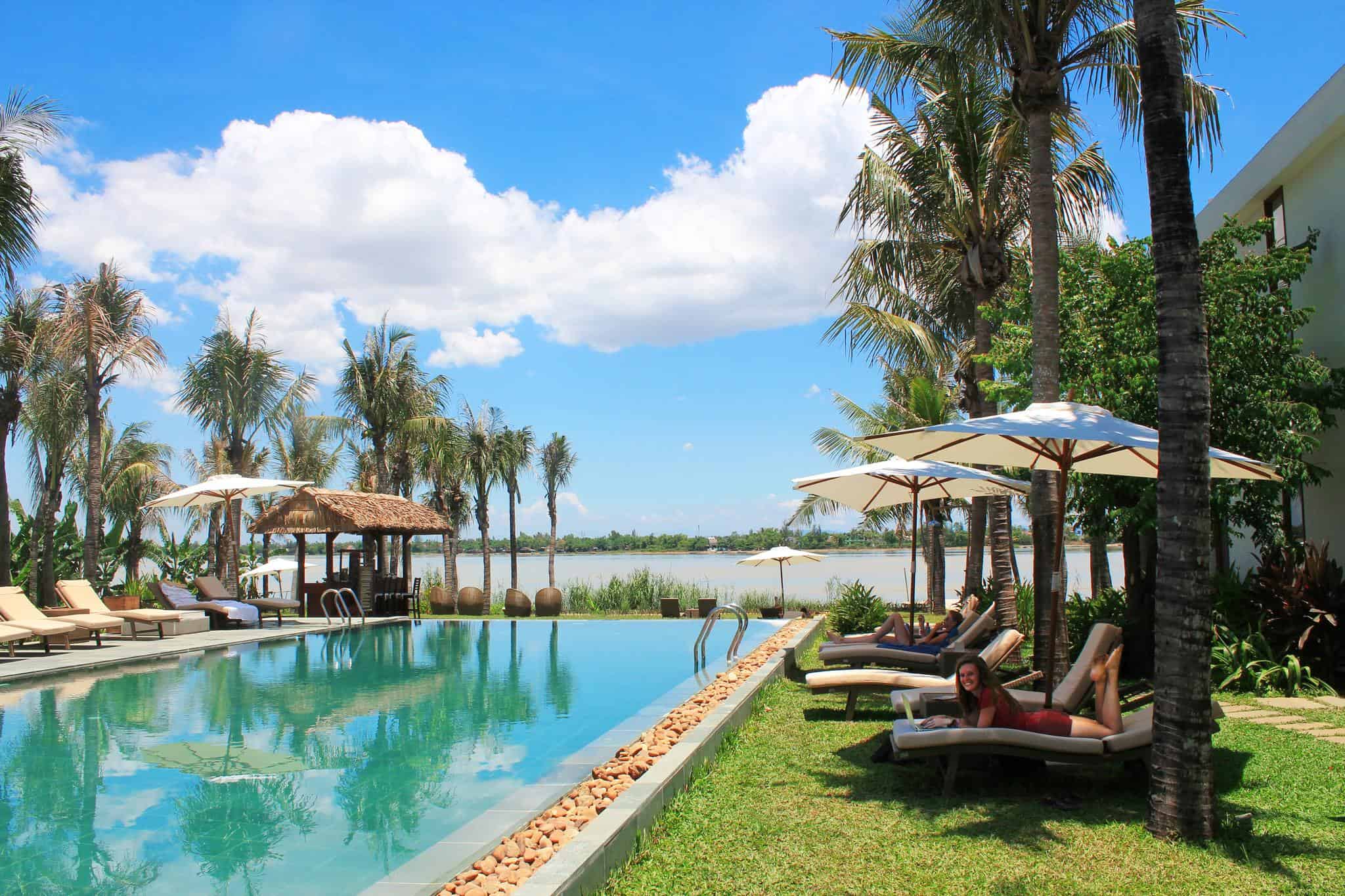
Step Seven: My Essential Plugins for Travel Bloggers
You've got all of the design features of your site installed at this point, so it's time to start working on some of the behind-the-scenes stuff. With your site almost ready to go at this point, you'll want to start installing some WordPress plugins. These will help improve the functionality of your site and give you access to a ton of new features.
Head over to the plugins section of your site and click on "add new". You'll then be able to search for the following plugins:
Akismet: I didn't realise how much websites are inundated with spammy comments until I started this site. At the moment, I receive 2 or 3 spam comments a minute. Fortunately, I don't have to see any of them because Akismet catches and deletes them automatically.
Comments Not Replied To: Building a community is important, and this plugin shows you a list of comments you haven't replied to yet. If someone spends their time commenting on your blog, it's worth taking a few minutes out of your day to reply. Plus, if your readers can see you reply to everyone, they'll be more likely to leave a comment themselves.
Contact Form 7: This will add a form to your contact page so that people can email you.
Interactive World Maps:Have you seen the beautiful map on my Where I've Been page? It's a plugin called Interactive World Maps, which I highly recommend getting. It's a paid plugin, so it's not something to opt for if you're trying to keep your costs low, but if you want a beautifully designed map to showcase your travels, this is the one to go for.
Yoast SEO:If you install only one plugin, make it this. Yoast SEO makes it so easy to improve your rankings in Google and is the absolute best plugin out there. It comes with hundreds of features and options so I won't list them out there, but needless to say: you need this.
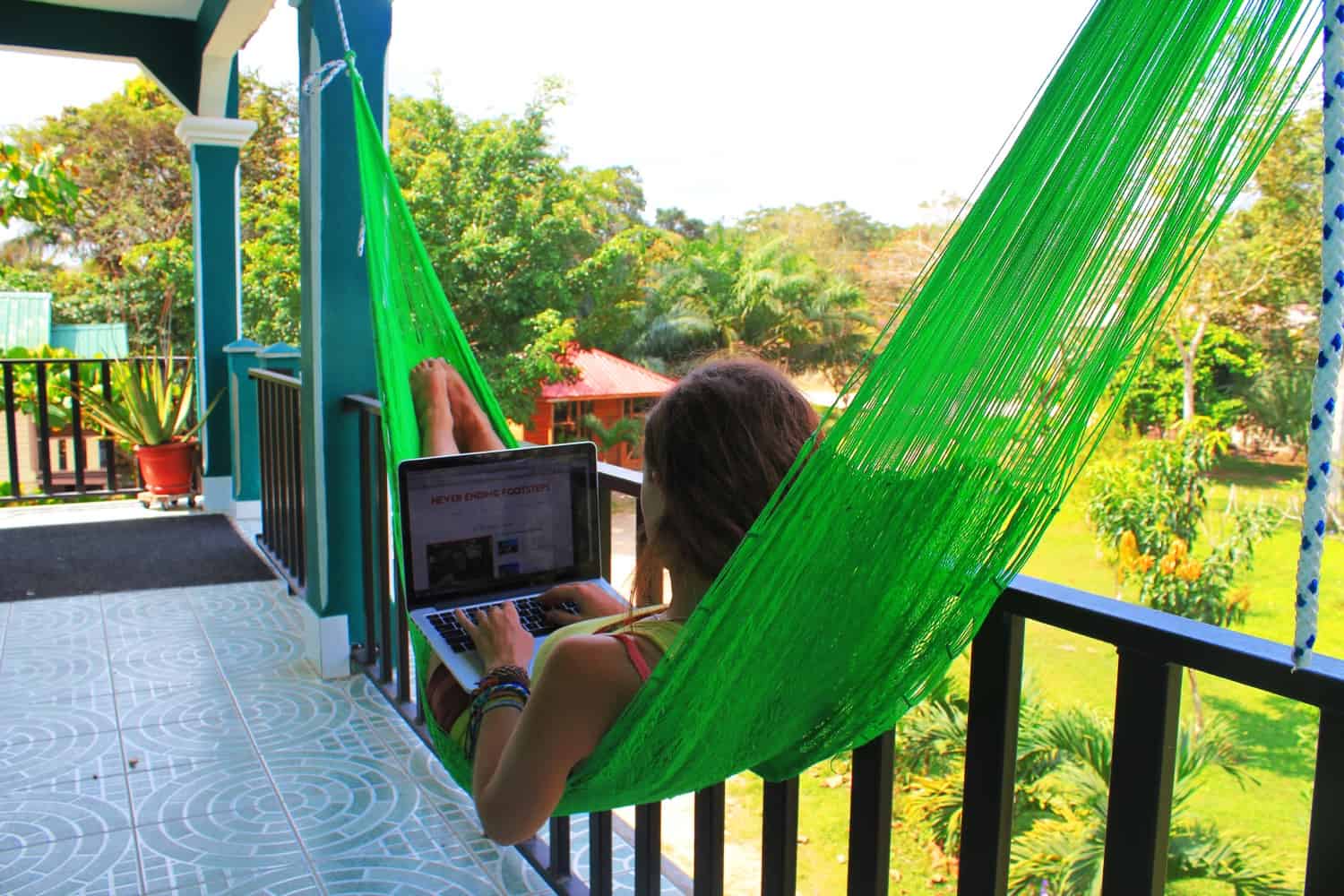
Step Eight: Your First Blogging Steps
Create an about page: Before you even publish your first post, you should create an about page. The first thing I do whenever I arrive on a travel blog for the first time is find out who the blogger is, what they're currently doing, and why I should care about them. An about page is so, so important. It tells potential readers why they should follow along on your journey. This is also the place to let your personality shine! Share weird facts about yourself, tell people why you want to travel, show them you're human and worth following. You want to be anything but boring here, as this is your chance to grab your readers and convince them to stick around.
Write your first post: After you've got your about page sorted, make your first blog post about you. Tell people why you started the blog, what it's going to be about, where you're going, and where you've been. Your introduction is how people will get to know you and it helps kick your blog off with a bang. Once you've written it, start sharing it on social media — Facebook, Twitter, and Pinterest are where you're going to want to start publicising your wonderful content.
Don't be afraid to let your personality shine through: Don't be boring. When I decided to start a travel blog, I was so focused on appearing professional and being an expert that I ended up writing bland posts that read like a Wikipedia article. Little did I know, it's your personality that's going to convince people to subscribe. Once I embraced my inner idiot and started writing about the ways I'd screwed up on the road, my traffic skyrocketed. It's so important to have a personality in blogging; don't try to be a guidebook. Be a person. Be yourself. Even if you're really weird. One thing that helps me achieve this is to write my blog posts as I would speak, then tidy up the grammar and sentence structure afterwards.
Create a business plan: Nobody talks about this, but it's so important! If you want to find success, you need to treat your travel blog just like any other business.How are you going to find success? How will you monetise your site? How will you build an audience? Where do you want to be in three months? Or in a year? Which companies do you want to work with? Where do you want to be featured? Start thinking long-term, write down your goals, and start working towards them from day one.
If I was starting a travel blog in 2021, my plan would involve joining dozens of Facebook groups to network with other travel bloggers, looking for travel blogging guest post opportunities to build links to my site, focusing on Pinterest to build traffic, writing 3,000+ word resources that are better and more detailed than anything on Google's first page, and making $500 a month. You should be able to achieve that income goal within 3-6 months of starting your travel blog.
Install Google Analytics: You'll want to be able to record how many people visit your site each day, so Google Analytics is a must. This will allow you to track your traffic and find out more about your readers. Don't get obsessive over it though! It's far too easy to waste an entire day staring at your live analytics. Check every couple of days to see which posts are receiving traffic and whether it's increasing or decreasing over time.
Stand out from the crowd by doing things differently: There are hundreds of thousands of travel blogs out there now. How are you going to stand out from the crowd? I'm a contrarian so if I see that everyone's doing something, I try to do the opposite in order to find a niche.
I don't take press trips or sponsored hotel stays or even accept free products for review. Why? Because every travel blogger does all of those things and I knew it was one of the things their readers dislike most about their blogs. I decided I'd pay for everything myself and travel how non-bloggers travel and have received nothing but amazing feedback in response to it.
I don't offer advice on how to travel the world. Instead, I write about how I screwed up while travelling, because nobody else is doing that. And because travel isn't always amazing but so many travel bloggers pretend that it is. I don't make out that my life is perfect and I'm living the dream — instead, I write frequently about my battles with anxiety and what it's like to deal with a mental health disorder on the road. I write about what it's like to get lost in every goddamn city you visit; about how it feels to get scammed for the twentieth time in a year; about how to deal with your boat starting to sink in Thailand.
Everyone says to create a regular posting schedule. I didn't start off by posting regularly though, and I never have. Bloggers say to post three times a week, but sometimes I've posted once a week for months on end. When I got a book deal, I posted once every three months and my traffic still grew. Interestingly, I once posted every single day for a month and my traffic dropped! Most important of all is focusing on your quality of writing. Don't rush to post as much as possible if it's going to sacrifice the quality of your work.
There are some things that will help you find success and that's why everyone's doing them. Go self-hosted with Bluehost, come up with a catchy name, find a beautiful theme, and come up with a way to brand yourself. But everything else isn't as important. Post when you want, travel where you want, and write about the things that interest you. Be yourself. That's the way to build a successful travel blog.
How Do You Make Money With a Travel Blog?
A lot of travel bloggers recommend waiting until you've built a large and engaged audience before you even start to think about monetising your site, but I don't think it's necessary. There are plenty of ways to start earning money that won't negatively affect your growth or annoy anyone who visits your site. Here's how I recommend getting started:
Adsense: The easiest way to start making money with advertising is through Adsense. Sign up for an account, enter in the ad settings you want (I've received the most success with a 300×250 sized banner placed below the first paragraph of a post), and then you're good to go! Download the Quick Adsense plugin, too, as it makes placing the ad code anywhere on your site straightforward. Experiment with different placements, too.
You should be able to make as much as $1 per 1,000 visitors to your site if you have enough placements, and while that won't sound like much, once you reach 25,000 visitors a month, you can leave Adsense, join Mediavine and start making 10x more money with advertising. There are plenty of new travel bloggers who manage to reach 50,000 page views a month in under a year — with Mediavine, that means making around $750 a month in ad revenue, which is enough to live off in cheaper countries like Vietnam.
Amazon:If you want to get started with affiliate marketing (and you definitely should — I make those annual six figures from affiliate marketing alone!) Amazon Associates is best for beginners. Any time you mention a product on your site, you can search for the product through Amazon Associates, and then use that link in your post. Whenever your readers click on that link and choose to buy anything, you'll receive a commission on that sale. Packing lists, in-depth reviews, and gift guides are great for monetising through Amazon, so get started with those.
I have packing lists on my site that make me over $200 per post each month in Amazon commissions, so if you can write a detailed packing list and get it ranking first in Google, this is a great way to make money before you have a huge audience. Write five of them and you've got $1000 coming in each and every month.
Other affiliate programs:As long as you don't go overboard and stuff every single paragraph with a ton of affiliate links (which can always be tempting!), there's no reason why you can't join other affiliate programs, too. Some popular ones that I use and recommend include World Nomads for travel insurance, Agoda and Booking.com for linking to accommodation I've stayed in, and Skyscanner for whenever I talk about finding inexpensive flights. That way, when you write a detailed travel guide for a place, you can recommend the hotel you stayed in, share how you found cheap flights, and recommend that your readers take out travel insurance, and make money whenever somebody clicks those links and follows your recommendation.
I have a single post on my site that brings in $1,500 a month in Booking commissions alone, so you can see how lucrative affiliate marketing can really be.
Most important of all: I use every single one of these companies and have done since the very first day I started travelling. If you hate Skyscanner and never use them, for example, don't then recommend them to your readers just so you can make money from them. You gotta be ethical!
The best thing about affiliates is that you can start making money from day one. If you start your travel blog off by writing a travel guide to Athens and find that it makes its way to the first page within the next month or so, you can add affiliate links to that post and make a decent amount of money from it — even though your overall blog doesn't get that much traffic.
That's all I'd focus on right now. I'd steer away from monetising your social media, trying to get comped travel, and running branded content posts/sponsored posts in the early stages, if not forever, because they're most likely to annoy your readers.
How Much Does it Cost to Start a Travel Blog?
Now that I've covered how to make money with your site, let's take a look at the upfront costs you can expect to pay to keep a blog running. Here are several options:
You want to run a blog to keep friends and family informed of your travels: free
If your aim is to keep a record of your travels for your friends to follow along with and you have no desire to turn it into a business, there's no need to make an investment up front. Instead, I recommend heading to WordPress.com (rather than .org) and setting up your site through there. You won't have to pay for hosting and you'll have access to free themes to use on your travel blog.
You want to start a professional travel blog but don't have much money to do so: $109
There are definitely ways that you can cut corners without sacrificing the overall quality of your travel blog.
I've yet to come across a popular travel blog that wasn't self-hosted, so that's an essential. When it comes to a theme, having a slick and modern one will create a better first impression, so I think that's important, too. Opt for a ThemeForest theme in this case, for around $50, and you'll be well on your way to building a wonderful travel blog.
For your logo, go for Canva if you're trying to save money. They have some pretty impressive banner designs that won't cost you a cent to use, and you can hire a professional designer further down the line as you find success. Skip everything else that's paid at this point — you can invest in those later on once you start making money with your site.
If you're tight on money, then, you'll find you'll pay $59 for your Bluehost hosting, $50 up-front for a professional theme, and that's it!
You're determined to build a successful, lucrative travel blog as quickly as possible: $150 up-front
If you've got money to spend and you're ready to dedicate as much as you can to getting your travel blog off the ground, you'll be looking at large up-front costs. You'll also likely start making money within your first year of blogging, if not sooner.
You'll cover the basics with a Bluehost hosting plan for three years ($100), and then splurge on a ThemeForest theme for around $50.
You're me: $330 a month
Ha! I'm including me in this list because you're most likely curious to know how much you'll be looking at spending on a site once you're successful. Here's how my main monthly expenses break down:
- I pay over $2,000 a year to host my site with Performance Foundry.
- I spend $700 a year for newsletter services with ConvertKit.
- I spend $600 a year to schedule pins on Pinterest with Tailwind.
- I pay $400 a year for accounting software with Xero.
- I pay $250 a year to host my travel photos online with Crashplan.
It sounds like a lot, but keep in mind that I make well over $10,000 a month from my travel blog, so they're all expenses that I can justify.
Is It Too Late to Start a Travel Blog in 2021?
I receive a lot of emails and comments from readers who are concerned it's too late to start travel blogging. Is it? Nope! Hell no. Seriously — it's not too late.
And the pandemic? It caused a lot of travel bloggers to give up. While the travel blogging world used to be super-crowded, it's now thinned out over the past year, as bloggers who were reliant on press trips began to run out of money. And now that the world is starting to return to normal, those of us who focused on passive income are doing better than ever before, with less competition than before.
It's a great time to start.
And you know what? There are so many more opportunities for income than there used to be. When I started out, there were only a handful of travel bloggers who made $1,000 a month, and they were the people who had been blogging for several years. These days, there are several hundred travel bloggers who are pulling in six figures each and every year.
In Facebook groups, I see new bloggers sharing how they managed to reach 100,000 page views in just a year or two of blogging — something that used to take the original travel bloggers three or four years to manage.
I believe that if I were to start my travel blog today, I'd be able to reach my current income within two years. So don't be dissuaded by the sheer number of travel bloggers on the internet today — focus on generating traffic then monetising your audience, and you'll be doing well in no time at all!
Now Get Blogging!
I have one final suggestion, and that's to take a look through the comments of this article below. I now have almost a thousand comments on this article from people asking questions and looking for advice. My answers will likely be useful as you start your travel blogging journey, and feel free to ask for any clarification in the comments, too!
And most of all, good luck! You can totally do it :-)
How To Be A Travel Writer Blog
Source: https://www.neverendingfootsteps.com/how-to-start-a-travel-blog/
Posted by: jonesfladdre41.blogspot.com

0 Response to "How To Be A Travel Writer Blog"
Post a Comment